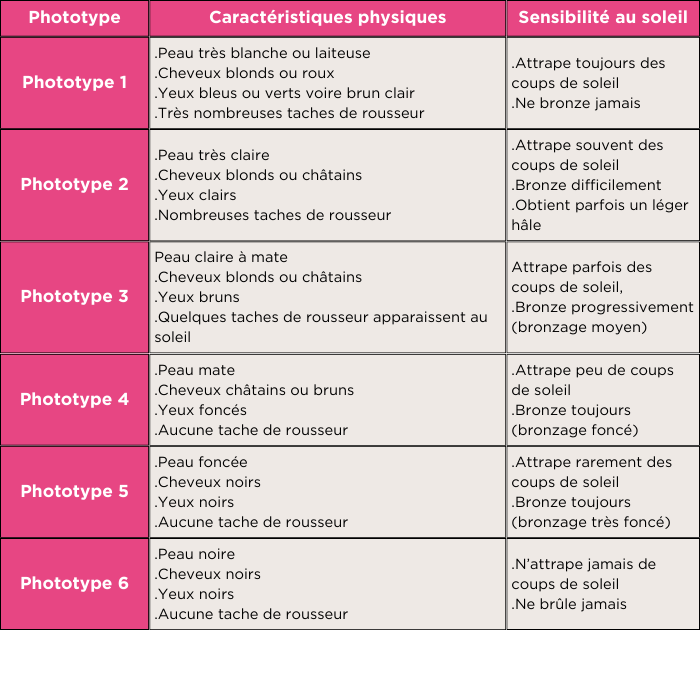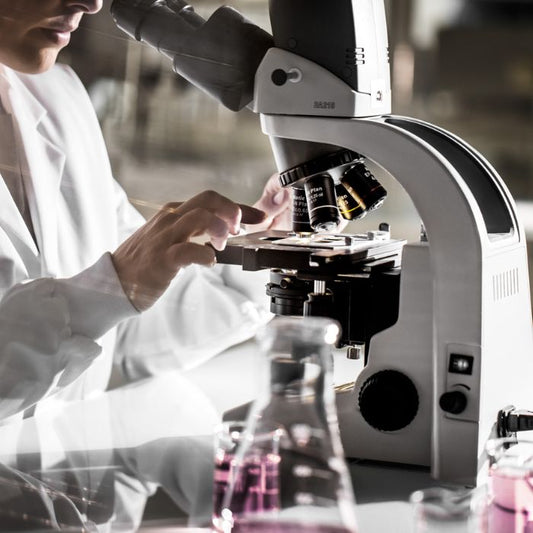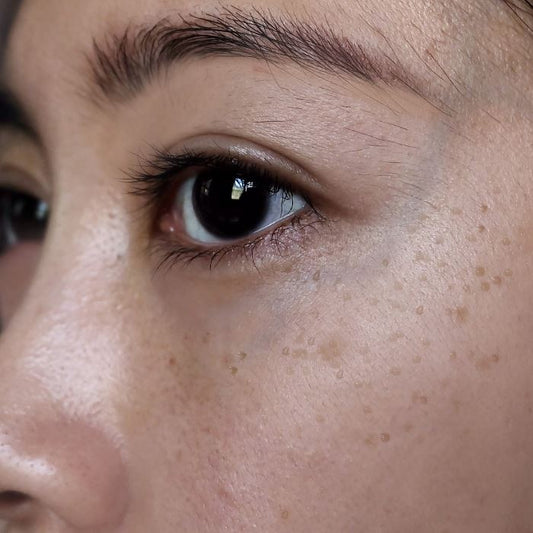Sun and Skin: Understanding what is happening at the heart of your epidermis

Topicrem celebrates its 30th anniversary!
0,00€
It beautifies our life and our complexion, warms us, and is essential to our well-being. However, it should be consumed in moderation. It's about the sun! And the first to suffer the damage is our skin.
If you want to know more about skin pigmentation, photo aging, but also about the benefits and harmful effects of the sun, this article has been written for you.
The sun emits 3 types of radiation, each characterized by their length:
With wavelengths between 700 and 2,000 nm, it is to these rays that we owe the sensation of heat from the sun.
With a wavelength between 400 and 800 nm, visible rays allow us to see the world in color. Blue, green, red... our eye is capable of seeing these rays.
With a wavelength between 100 and 400 nm, these are the most energetic rays in the solar spectrum. UV rays cause the most damage to our skin and are particularly responsible for its accelerated aging.
UV rays themselves are broken down into 3 rays reaching our skin more or less deeply¹ :
UVA rays penetrate the skin to the dermis. More precisely, 80% of UVA rays pass through the epidermis and 20% reach the dermis.
UVB is blocked by 70% by the stratum corneum and its components (keratin and melanin) on the surface of our skin. Only 20% of UVB rays reach the deep epidermis, and less than 10% reach the dermis.
UVC does not impact our skin because it is absorbed by the ozone layer. They therefore do not penetrate our atmosphere and do not reach the Earth's surface.

We are not all subject to the same solar radiation depending on our geographic location and our environment. Several criteria come into play:
Source: https://www.who.int/fr/news-room/questions-and-answers/item/ultraviolet-(uv)-radiation
The natural color of our skin is determined, genetically, by its pigmentation. This is based on the activity of specific cells of the epidermis, the melanocytes, at the origin of the synthesis of the skin pigment: melanin.
Although all skin has the same number of melanocytes, each skin tone is characterized by a variable quantity of melanin and different types of melanin produced by the epidermis. What we commonly call melanin is, in reality, a mixture of several pigments:
Once produced by melanocytes, melanin diffuses into the layers of the epidermis. With cell renewal, it reaches the surface of our skin and gives it its natural tone.
Our skin color, or complexion, determines our phototype. There are 6 distinct phototypes used to classify skin colors according to their physical characteristics (skin tone, eye and hair colors) and their sensitivity to the sun. If you have fair skin, you certainly know that your skin's sensitivity to the sun is greater than that of dark skin.


Both friend and foe, the sun plays both roles. While it's essential for the proper functioning of our bodies and keeping our spirits up, the sun can also be dangerous if we overuse it: allergies, rashes, pigment spots, dehydration, acne, and even melanoma. That's why it's crucial to use an effective range of sunscreens, both during and after exposure .
We especially love the sun for the beautiful tan it gives us, as well as for its tanning action. When UV rays reach our skin, they activate its pigmentation mechanism. In this natural process, UV rays stimulate melanocytes, the epidermal cells responsible for producing melanin, the skin's pigment. Thus, under the effect of UV rays, our skin increases its melanin production. This then spreads throughout the epidermis, and our skin takes on color.
Two phenomena¹ occur when our skin is exposed to UV rays:
Whether immediate or delayed, pigmentation is primarily a defense mechanism of the skin to protect itself from the harmful effects of UV rays . In the presence of UV rays, melanin absorbs UV radiation to prevent it from damaging other cellular compounds (or organelles).

It is thanks to the sun that our body knows how to synthesize vitamin D, a very valuable vitamin for our skeleton and the maintenance of normal bones and teeth, but also for our immunity and effective natural defenses.
A short exposure to the sun is sufficient to meet our vitamin D² needs: simply expose your forearms and face for between 5 and 10 minutes, two to three times a week.

You've probably already felt it, the sun boosts our morale. And the feeling of well-being it gives us doesn't just come from its gentle warmth. It is proven that sunlight impacts the production of serotonin, the feel-good hormone, involved in many functions such as the sleep-wake cycle, mood, anxiety, and even pain. When the days get shorter and the ambient light is low, serotonin production drops, bringing with it a drop in our morale. This is why our morale is better in summer.
If the sun presents some significant benefits for our well-being, we must nevertheless be aware of its harmful effects which weigh heavily in the balance. Here's why the sun isn't just a friend.

Also known as summer light eruption , sun allergy usually occurs after the very first exposure of the skin to the sun. Sun allergy manifests itself by the appearance of small spots or larger papules, with a strong urge to scratch. It can persist for a few days and eventually fades, not to reappear over repeated exposures.
Using sunscreen can help significantly reduce the duration and intensity of the allergic reaction.

Sunburn appears after prolonged and high intensity exposure of the skin to UV rays. This is a skin burn mainly caused by UVB (and to a lesser extent by UVA). Fair skin is even more prone to it. Solar erythema can affect the skin with 4 degrees of intensity ³ , from a simple pinkish coloring of the skin, to the appearance of pain and intense burning sensations, edema, or even blisters (blisters) filled with liquid. Sunburns also cause more or less significant peeling of the skin. The risk of “getting a sunburn” is all the greater the lighter the phototype.
You have probably already noticed that your tanned skin is often dehydrated. Skin hydration is based on several parameters including the presence of lipids in the lipid cement between the cells of the epidermis. UV rays are responsible for the oxidation of these lipids. Degraded, they can no longer effectively play their role as cement and allow water to evaporate, thus leading to dehydration of the skin.
UV rays trigger the production of melanin. Over time, this natural process becomes less efficient, becomes disrupted and leads to the appearance of pigment spots, or solar lentigos.
Melasma is another form of skin hyperpigmentation induced by the combination of sunlight and the female sex hormones estrogen and progesterone. Melasma mainly affects women, including pregnant women and those on contraception, and occurs over large areas of the face.
If during exposure to the sun, acne seems to improve, this is without taking into account the rebound effect which generally occurs once exposure is over. Indeed, at first glance, the sun has a drying effect favorable to oily and acne-prone skin. However, when the exposure stops, the epidermis has thickened, which prevents the proper natural flow of sebum through the pores. This obstruction then promotes the retention of sebum in the skin and the inflammatory lesions characteristic of acne.

Also called helioderma, photoaging is the aging of the skin induced by chronic exposure to the sun. It mainly affects photoexposed areas such as the face, forearms, neckline, and hands.
Photoaging results from several phenomena induced by UV ⁴ :
At the clinical level, this results in more marked signs of aging: deepening of wrinkles, loss of elasticity, sagging and loss of firmness, loss of skin density and the appearance of spots.
The sun is classified as a carcinogenic factor by the IARC (International Agency for Research on Cancer). More than 80 % of skin cancers are caused by overexposure to UV rays. Skin cancers develop over the long term and result from UV-induced mutations in our genes. Exposures in childhood and adolescence are decisive in the occurrence of cancers in adulthood.
In order to prevent the risk of skin cancer, it is recommended to avoid as much as possible (or limit when it is not possible to avoid) exposure to the sun, and above all, to protect yourself effectively. with sun protection containing filters.
At the slightest change in your skin, it is then essential to intervene as early as possible, it is essential to be attentive: if a new brown spot appears or if a mole seems to be changing, do not hesitate to consult a dermatologist for a precise examination.
The TOPICREM face and body care formulas have all been designed to provide protective hydration and preserve the skin barrier of sensitive skin for the whole family.
To do this, our laboratory relies on its expertise derived from pharmaceutical excellence:
¹ Mélissopoulos A, Levacher C. The skin, structure and physiology, 2nd edition. Lavoisier.2012.
² Weekly epidemiological bulletin, May 22, 2012/ n°18-19, National Health Monitoring Institute available at: http://www.invs.sante.fr/fr/content/download/36751/177365/version/3/file /beh_18_19_201 2.pdf
³ Warrick E. Tissue effects of UV [Internet]. https://biologiedelapeau.fr. 2014. Available at: https://biologiedelapeau.fr/spip.php?article74
⁴ Leccia MT. Photo-induced skin aging. EMC - Cosmetology and aesthetic dermatology. Jan 2006;1(1):1-10.
⁵ https://www.worldwidecancerresearch.org/

Exposing yourself to the sun is generally a pleasant time. But for it to remain so, certain impor...
Read the article
Are “natural” cosmetics really better than synthetic ones?
Read the article
A simple disturbance and your skin reacts? Nothing suprising ! Much more than a simple envelope, ...
Read the article
Skin pigmentation is the natural biological process of coloring our skin. When it is well regulat...
Read the article



